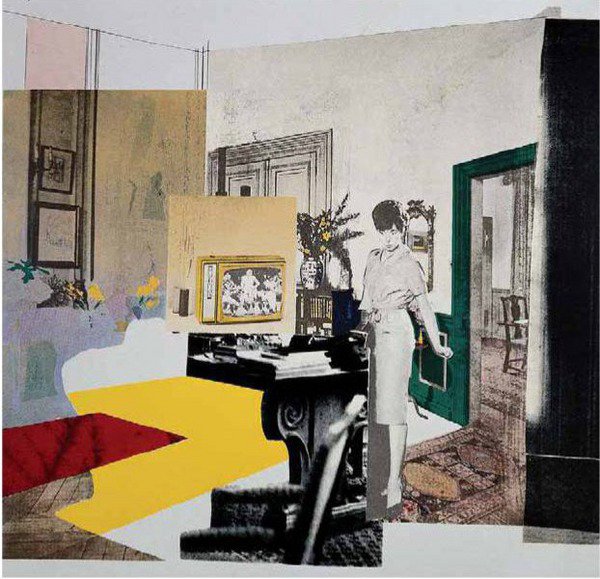Pieces, Patterns, Lines
dal 9/5/2012 al 25/8/2012
Segnalato da
9/5/2012
Pieces, Patterns, Lines
IVAM Instituto Valenciano de Arte Moderno, Valencia
Collage in the IVAM's Collection. The artists are decisive: Schwitters, Moholy-Nagy, Laszlo' Peri, Hamilton, Rauschenberg, Oldenburg... to name only those that are of unquestionable international stature. The works are arranged in sections of simply descriptive categories that indicate a possible itinerary.

A hundred years have passed since collage was invented and popularised in the international art world as a surprising and skilful figurative strategy openly at odds with the tradition of illusion: the constructive canon of European visual representation. This seems to be a timely moment, therefore, for the presentation of a kind of inventory of the splendid collection at the Institut Valencià d’Art Modern, an institution that from the very outset, in this and many other areas of experimental art, displayed a strong commitment to the understanding and interpretation of the emerging artistic ideas formulated in the fray of the radical aesthetic battle at the beginning of the twentieth century.
Collage was an idea – a playful notion, perhaps, in the first attempts – formed in 1912 from a mélange of chance and irony by Picasso, who encountered the immediate complicity of Braque. It instantly aroused the enthusiasm of Juan Gris, another pioneer of Cubist painting. With time, collage succeeded in become the frontier of the Comanche territory of the artistically incorrect, the decisive domain for any formal inventiveness that was innovative and bold – from Expressionism to Surrealism, the militant advance party of photomontage and the lacerating publicity of war; the provocative projects of Dada and the intermittent offerings of jazz, at the time of the Ballets Russes and the harsh dissonances of cabaret, which would be poorly assembled and assimilated worse without the disconcerting combinations of collage, a sturdy testing ground on which the artist showed the possibilities of exchanging forms and thus the effectiveness of his most daring initiatives to make visual material expressive.
Always focusing, however, on hybrid assembly, formal objectification or simply the old artistic ceremony of causing discomposure, an arrogant unsettler in the awakening of contemporary aesthetics. Artistic interventions in closed spaces or on diaphanous artistic surfaces, participative performances, dramatisations of narrative rituals or coded scenographies and even recent state-of-the-art technologies have turned back to collage as a system that ensures results when it comes to stimulating a living aesthetic experience.
Collage is the art of superimposition, of the meaningful unit forcibly placed between somewhat unorthodox and sometimes antagonistic perceptible items, an art “of discontinuity, montage and fragments, of cut and paste”. We must not forget – and it is an essential condition of survival for any public art space – that the contemporary sensibility declares itself in a variety of frequently conflicting ways. And so, of course, they go back to collage, as art and as artistic attitude, as a hazardous horizon of imagination that we might describe as soluble – the preferred term nowadays is liquid – prepared for action in any ideal sphere of perceptual signification. Which would call into question once again the incisive observation made by Ortega y Gasset in 1925, showing caution at a time of backlash against the avant-garde: “The art of the past is not art, it was art.”
The artists and works selected for this occasion reveal the extent of the risk that the IVAM took in the early days of its collection. The artists are decisive: Schwitters, Moholy-Nagy, László Péri, Hamilton, Rauschenberg, Oldenburg … to name only those that are of unquestionable international stature. Moreover, as a methodological guide to aid the visitor, the works are arranged in sections of simply descriptive categories that indicate a possible itinerary and help us to appreciate these works and objects of art, always unusual and autonomous, and their formal contribution to a dazzling figurative riddle still capable of surprising the most exacting visitor:
I. Matter. Form
II. Image. Figure
III. Sign and Gesture
IV. Memory, Tradition and Experimentation
V. Narrative and Action
Image: Richard Hamilton
Department of Communication (34) 96 386 76 79 or send an e-mail to comunicacion@ivam.es
IVAM Institut Valencià d'Art Modern
Guillem de Castro, 118, 46003 Valencia
Opening hours: Tuesday to Sunday and holidays from 10.00 to 20.00h.
Monday closed, except national or autonomous holiday



